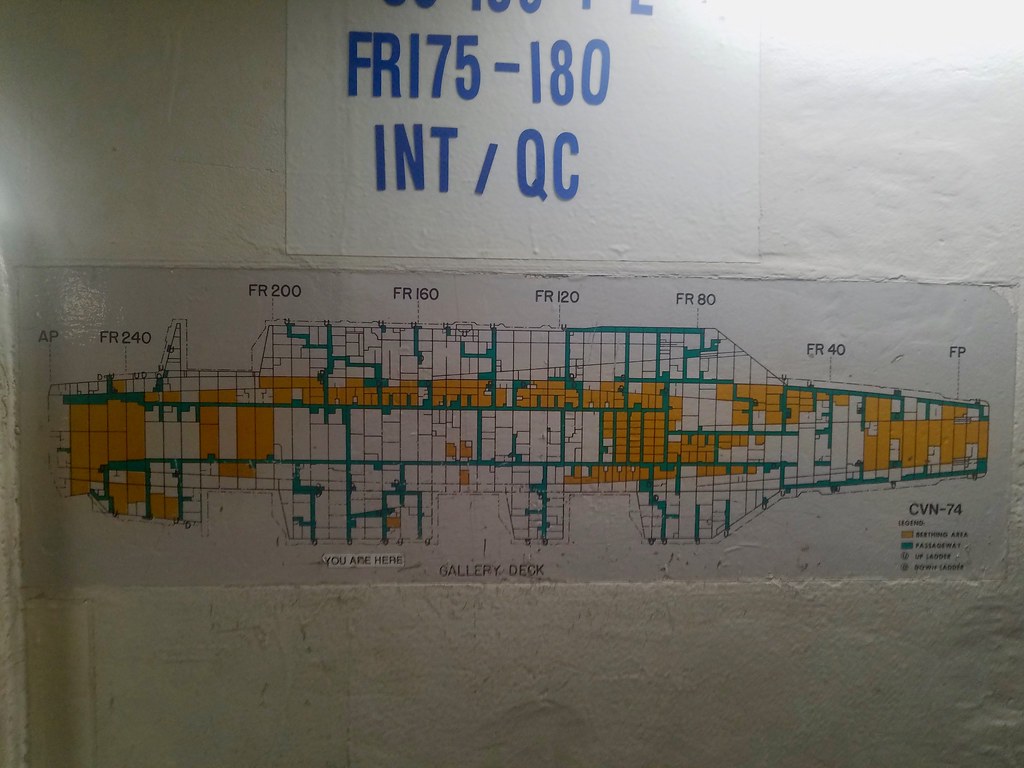The USS John C. Stennis felt like an otherworldly city, with some things strange and others more familiar. For example, the Internet did not exist there, at least not for us, and neither did mobile phones. Scarce satellite bandwidth had to be doled out. Sailors could check email every once in awhile; short-term visitors such as ourselves deserved none. Several thousand people averaging about 20 years of age got little social media access and they weren’t tethered to screens like their civilian counterparts. It seemed like a step back in time. Lots of other things seemed just a little out of place too.
Passageways

Passages of varying lengths ran along decks, punctuated by endless doorways and occasional stairwells. A ladder filled each break between decks, a nearly vertical set of stairs with handrails. Our guides used passageways effortlessly, delivering us anywhere in the ship within a few minutes. I could never replicate their routes if I tried. Repetition and practice allowed them to move freely through tight spaces and slip between decks.
An oval-shaped cutout appeared every few yards as we walked down the passageways through successive compartments. Most of them required an upward step over an iron ledge to continue. The crew called these “knee-knockers” and they would cause a nasty bruise if misjudged. We went over these hundreds of times during our visit. Thankfully I never knocked a knee.

Sinking would be the most obvious danger on such a large object floating so far out at sea. It didn’t bother me though. Little chance of that existed. Nonetheless, the ship still needed to be prepared for that remote possibility. After all, the Stennis existed for a wartime purpose and someday it could be involved in armed conflict. Sealable hatches, doorways and compartments existed at various strategic points throughout the ship. They could localize flooding and keep the ship afloat if damaged.
Here

The interior walls displayed frequent “you are here” signs. On this particular sign from the Gallery Deck, orange coloring marked berthing areas and green marked passageways. Little symbols also marked up and down ladders. Signs like this showed relative deck position; fore to aft, port to starboard. Crew could quickly determine their location and use these signs to navigate with a little practice.
We didn’t have enough time on board for me to figure it all out. My biggest problem tied-back to the lack of windows. I couldn’t get my bearings so I never got much of a sense of where I might be at any given moment. The guides didn’t have the same issue so I just stuck close to them and followed along. They did tell us what to do it we got separated and lost though. We should simply wait and let the guides find us. Nothing would be worse, they said, than having us wander around trying to get back.
Funny, that seems to be the same advice people get when they hike in the wilderness.
The Hotel

Everyone in our group stayed on board overnight in a row of cabins towards the ship’s bow, along a passageway closed to walk-through traffic by curtains at either end. Signs at the entrances called this the Hotel, a little private place for overnight Distinguished Visitors. Six cabins for twelve visitors meant doubling-up. Only a handful of people on an aircraft carrier get a single cabin, like the Admiral, the Captain and other selected higher-ranking officers.
Still, sharing a fairly roomy cabin with only one other person would be considered a luxury here. Many of the enlisted crew occupied berths containing row after row of racks, sharing space with a hundred or more of their closest friends. Rank definitely had its privileges. We also learned rather quickly to use the officers’ head rather than the enlisted, a definite step up in cleanliness.
Our cabin looked comfortable and I thought I’d get a lot of sleep. We’d climbed all over the ship for hours and I felt exhausted. Well, an aircraft carrier never truly quits working. Jets moved continuously and our cabins sat just a few feet below the catapults. For me, earplugs made no difference even though they muffled the sound because the bed shook every time a plane left took off. That’s simply life on an aircraft carrier and I’m not complaining. We caught a break, too. Flights stopped around 1:30 a.m. on this training mission. They can go 24×7 during normal operations. People get used to this after a few days apparently, or so I’m told.
Fitness

How does one keep a military crew in peak physical condition in such a confined space? Part of the answer seemed to involve stashing exercise equipment in random nooks throughout the ship in addition to a couple of small gyms. I found these treadmills and stationary bikes in a corner of the hangar bay. We saw more equipment stored in the most unlikely places, even on the flag bridge.
A major ship like the Stennis also had two civilians on board who held curious titles, Fit Boss and Fun Boss. The Fit Boss ran a fitness program for the crew and maintained all of the exercise equipment. The Fun Boss organized recreational activities, sometimes fitness-related sometimes not, often in coordination with the Fit Boss. Anyone can apply for these jobs without joining the Navy and currently get paid $45,000 – $50,000 a year to sail around the world.
Articles in the Aircraft Carrier Series:
- Getting to Norfolk
- All Aboard
- Air Power
- The Island
- Living Aboard
- Feeding Time
- Always Working
- Other Spaces and Places
See Also: The Complete Photo Album on Flickr

Leave a Reply